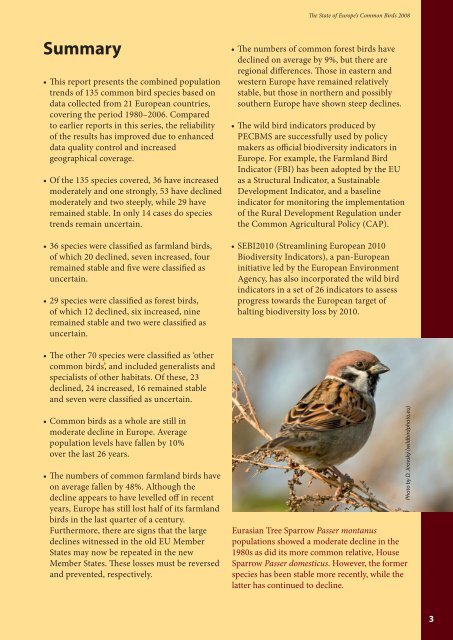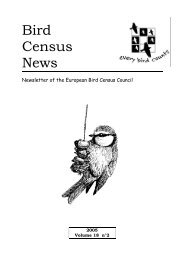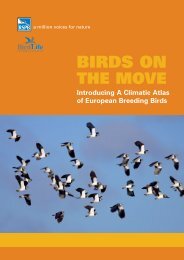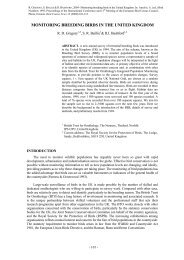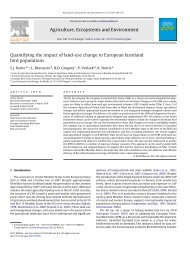The State of Europe's Common Birds 2008 - European Bird Census ...
The State of Europe's Common Birds 2008 - European Bird Census ...
The State of Europe's Common Birds 2008 - European Bird Census ...
Create successful ePaper yourself
Turn your PDF publications into a flip-book with our unique Google optimized e-Paper software.
<strong>The</strong> <strong>State</strong> <strong>of</strong> Europe’s <strong>Common</strong> <strong><strong>Bird</strong>s</strong> <strong>2008</strong>Summary• This report presents the combined populationtrends <strong>of</strong> 135 common bird species based ondata collected from 21 <strong>European</strong> countries,covering the period 1980–2006. Comparedto earlier reports in this series, the reliability<strong>of</strong> the results has improved due to enhanceddata quality control and increasedgeographical coverage.• Of the 135 species covered, 36 have increasedmoderately and one strongly, 53 have declinedmoderately and two steeply, while 29 haveremained stable. In only 14 cases do speciestrends remain uncertain.• 36 species were classified as farmland birds,<strong>of</strong> which 20 declined, seven increased, fourremained stable and five were classified asuncertain.• 29 species were classified as forest birds,<strong>of</strong> which 12 declined, six increased, nineremained stable and two were classified asuncertain.• <strong>The</strong> numbers <strong>of</strong> common forest birds havedeclined on average by 9%, but there areregional differences. Those in eastern andwestern Europe have remained relativelystable, but those in northern and possiblysouthern Europe have shown steep declines.• <strong>The</strong> wild bird indicators produced byPECBMS are successfully used by policymakers as <strong>of</strong>ficial biodiversity indicators inEurope. For example, the Farmland <strong>Bird</strong>Indicator (FBI) has been adopted by the EUas a Structural Indicator, a SustainableDevelopment Indicator, and a baselineindicator for monitoring the implementation<strong>of</strong> the Rural Development Regulation underthe <strong>Common</strong> Agricultural Policy (CAP).• SEBI2010 (Streamlining <strong>European</strong> 2010Biodiversity Indicators), a pan-<strong>European</strong>initiative led by the <strong>European</strong> EnvironmentAgency, has also incorporated the wild birdindicators in a set <strong>of</strong> 26 indicators to assessprogress towards the <strong>European</strong> target <strong>of</strong>halting biodiversity loss by 2010.• <strong>The</strong> other 70 species were classified as ‘othercommon birds’, and included generalists andspecialists <strong>of</strong> other habitats. Of these, 23declined, 24 increased, 16 remained stableand seven were classified as uncertain.• <strong>Common</strong> birds as a whole are still inmoderate decline in Europe. Averagepopulation levels have fallen by 10%over the last 26 years.• <strong>The</strong> numbers <strong>of</strong> common farmland birds haveon average fallen by 48%. Although thedecline appears to have levelled <strong>of</strong>f in recentyears, Europe has still lost half <strong>of</strong> its farmlandbirds in the last quarter <strong>of</strong> a century.Furthermore, there are signs that the largedeclines witnessed in the old EU Member<strong>State</strong>s may now be repeated in the newMember <strong>State</strong>s. <strong>The</strong>se losses must be reversedand prevented, respectively.Eurasian Tree Sparrow Passer montanuspopulations showed a moderate decline in the1980s as did its more common relative, HouseSparrow Passer domesticus. However, the formerspecies has been stable more recently, while thelatter has continued to decline.Photo by D. Jirovský (wildbirdphoto.eu)3


